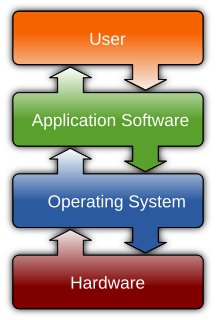Customer-relationship management (CRM) is an approach to manage a company's interaction with current and potential customers. It uses data analysis about customers' history with a company to improve business relationships with customers, specifically focusing on customer retention and ultimately driving sales growth.
A management information system (MIS) is an information system used for decision-making, and for the coordination, control, analysis, and visualization of information in an organization; especially in a company.

SAP SE is a German multinational software corporation that makes enterprise software to manage business operations and customer relations. SAP is headquartered in Walldorf, Baden-Württemberg, Germany with regional offices in 180 countries. The company has over 425,000 customers in over 180 countries and is a component of the Euro Stoxx 50 stock market index.

Microsoft Dynamics NAV is an enterprise resource planning (ERP) app from Microsoft. The product is part of the Microsoft Dynamics family, and intended to assist with finance, manufacturing, customer relationship management, supply chains, analytics and electronic commerce for small and medium-sized companies and local subsidiaries of large international groups. For modifications of the system, the proprietary programming language C/AL is used.

QAD Inc. is a company that provides enterprise resource planning (ERP) software to manufacturing companies.
Enterprise software, also known as enterprise application software (EAS), is computer software used to satisfy the needs of an organization rather than individual users. Such organizations include businesses, schools, interest-based user groups, clubs, charities, and governments. Enterprise software is an integral part of a (computer-based) information system.
Oracle Applications comprise the applications software or business software of the Oracle Corporation. The term refers to the non-database and non-middleware parts.
Microsoft Dynamics is a line of enterprise resource planning (ERP) and customer relationship management (CRM) software applications. Microsoft markets Dynamics applications through a network of reselling partners who provide specialized services. Microsoft Dynamics forms part of "Microsoft Business Solutions". Dynamics can be used with other Microsoft programs and services, such as SharePoint, Yammer, Office 365, Azure and Outlook. The Microsoft Dynamics focus-industries are retail, services, manufacturing, financial services, and the public sector. Microsoft Dynamics offers services for small, medium, and large businesses.
Microsoft Dynamics CRM is a customer relationship management software package developed by Microsoft. The product focuses mainly on sales, marketing, and service sectors, but Microsoft has been marketing Dynamics CRM as a CRM platform and has been encouraging partners to use its proprietary framework to customize it. It is part of the Microsoft Dynamics family of business applications.

Microsoft Dynamics SL is one of Microsoft’s enterprise resource planning software products for project-driven small- and medium-sized enterprises. It is part of the Microsoft Dynamics product family.
SAP ERP is an enterprise resource planning software developed by the German company SAP SE. SAP ERP incorporates the key business functions of an organization. The latest version was made available in 2006. The most recent Enhancement Package (EHP8) for SAP ERP 6.0 was released in 2016.
OpenMFG is an open source based, fully integrated accounting, ERP, and CRM enterprise software solution, from xTuple.

Apache OFBiz is an open source enterprise resource planning (ERP) system. It provides a suite of enterprise applications that integrate and automate many of the business processes of an enterprise.

Accounting software describes a type of application software that records and processes accounting transactions within functional modules such as accounts payable, accounts receivable, journal, general ledger, payroll, and trial balance. It functions as an accounting information system. It may be developed in-house by the organization using it, may be purchased from a third party, or may be a combination of a third-party application software package with local modifications. Accounting software may be on-line based, accessed anywhere at any time with any device which is Internet enabled, or may be desktop based. It varies greatly in its complexity and cost.
Openbravo is a cloud-based software provider specialized in retail solutions. The head office of Openbravo S.L. is located in Pamplona, Spain. Openbravo also has offices in Barcelona, Paris, Mexico DF and Kolkata. The company's main product is Openbravo Commerce Cloud, a cloud-based POS and Retail Management solution. For the worldwide distribution and implementations of its software, Openbravo relies heavily on its partner network. Openbravo is a multiple-time winner of Infoworld's Bossie award for best open source software application, last awarded in August 2014.
An ERP system selection methodology is a formal process for selecting an enterprise resource planning (ERP) system. Existing methodologies include:

FinancialForce is a cloud-based applications company headquartered in San Francisco, California, that provides a cloud ERP solution for Force.com, a cloud computing platform from salesforce.com. FinancialForce supplies Accounting, Billing, Professional Services Automation (PSA), Revenue recognition, Human Capital Management (HCM), and Supply Chain Management (SCM) applications.
abas ERP is an enterprise resource planning (ERP) & e-business application for manufacturers in the Assemble-to-Order, Make-to-Order and Engineer-to-Order environment. Manufacturer is ABAS Software AG, since 1980 based in Karlsruhe, Germany and interests in national and international companies that distribute the software.
Retail back-office software is used to manage business operations that are not related to direct sales efforts and interfaces that are not seen by consumers. Typically, the business processes managed with back-office software include some combination of inventory control, price book management, manufacturing, and supply chain management (SCM). Back-office software is distinct from front-office software, which typically refers to customer relationship management (CRM) software used for managing sales, marketing, and other customer-centric activities.









